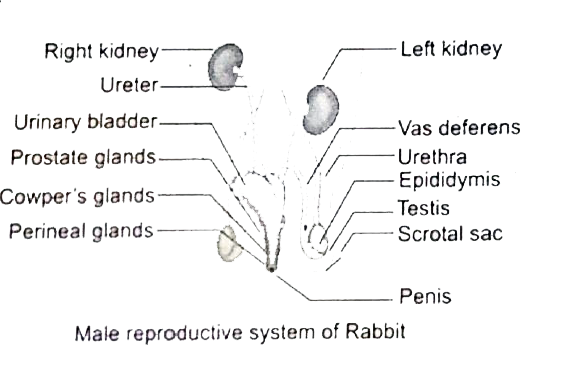(i) Explain the male reproductive systems of rabbit?
(ii) What are vestigeal organs?Solution in Tamil
The male reproductive system of rabbit consists of a pair of testes which are ovoid in shape. Testes are enclosed by scrotal sacs in the abdominal cavity. Each testis consists of numerous fine tublues called seminiferous tubules. This network of tubules lead into the sperm duct called vas deferens. The vas deferens join in the urethra just below the urinary bladder .The urethra runs backward and passes into the penis.
There are three accessory glands namely prostate gland, cowper.s gland and perineal gland. Their secretions are involved in reproduction.

The degenrated and non functional organs of animals are called vestigeal organs. Eg. Vermiform appendix, nictitating membrane, caudal vertebra, coccyx.
Topper's Solved these Questions
Similar Questions
Describe the rocket propultion.
19:35View Solution(a) (i) State Ohm's law.
(ii) With the help of a circuit diagram derive the formula for the resultant resistance of three resistances connected in parallel.02:48View Solution(i) What are the characteristic features of heat energy transfer?
(ii) Explain linear expansion with diagram?03:12View SolutionOrgans Of Male Reproductive System
05:42View SolutionOrgans of male reproductive system in human
05:28View SolutionExplain the male reproductive system of frog.
02:42View SolutionExplain the male reproductive system of rabbit with a labelled diagram.
05:42View SolutionExplain the male reproductive system of the earthworm.
02:12View SolutionExplain the male reproductive system of cockroach.
06:40View SolutionExplain the male reproductive system of rabbit with a labelled diagram.
03:38View SolutionName three accessory glands, which involve in male reproductive system of Rabbit.
04:23View SolutionExplain in brief reproductive organs of human male reproductive system.
04:03View SolutionExplain : Vestigeal organ
03:05View SolutionExplain in details : Male reproductive system
01:53View SolutionOrgans of male reproductive system in human
01:01:12View Solution

